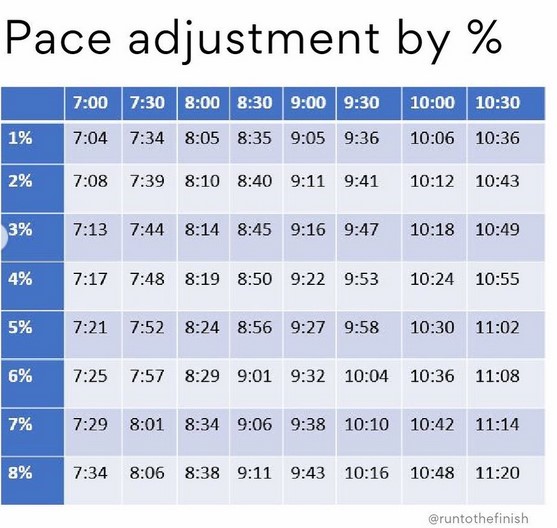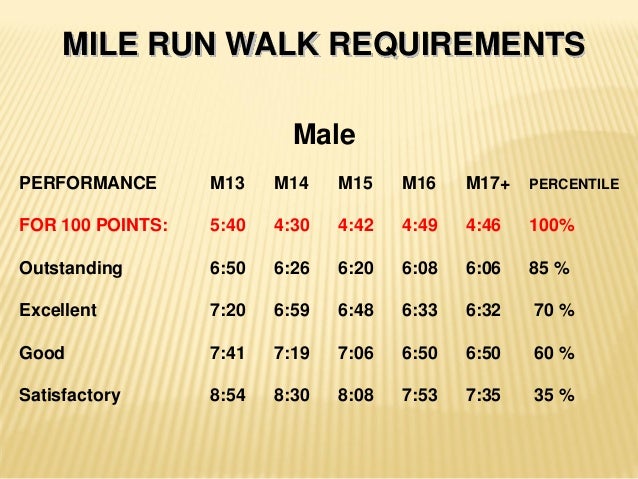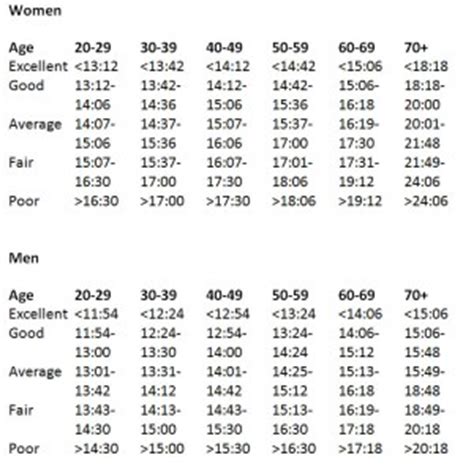Understanding the Importance of Benchmarking Running Times
Having a general understanding of average one mile run times by age is essential for athletes, runners, and fitness enthusiasts. By knowing the typical running times for different age groups and genders, individuals can set personal goals, monitor their progress, and identify areas for improvement. This knowledge can serve as a valuable benchmark, allowing runners to measure their performance against their peers and track their development over time.
Moreover, benchmarking running times can help athletes tailor their training programs to their specific needs and abilities. For instance, if an individual discovers that their one mile run time is significantly slower than the average for their age group, they may choose to focus on improving their speed and endurance through targeted training exercises and techniques. Conversely, if an individual finds that their running time is already above average, they may decide to maintain their current fitness level or shift their focus to other areas of their training.
In addition to providing a useful benchmark, comparing one’s running times to average times by age can also foster a sense of community and camaraderie among runners. By recognizing the shared challenges and achievements of their peers, runners can gain a greater appreciation for the sport and the efforts required to excel in it. Ultimately, benchmarking running times can serve as a powerful motivational tool, inspiring runners to push themselves to new heights and achieve their full potential.
Factors Influencing Running Times: An Overview
When comparing one’s running times to average one mile run times by age, it is crucial to consider the various factors that can impact performance. While age is a significant factor, other elements, such as fitness level, training, and environmental conditions, can also play a substantial role in determining running times.
Firstly, an individual’s fitness level can significantly affect their running times. Generally, individuals with higher fitness levels, such as those who engage in regular exercise, maintain a healthy diet, and avoid unhealthy habits like smoking and excessive alcohol consumption, tend to have faster running times than those with lower fitness levels. Moreover, individuals with a strong cardiovascular system, muscular endurance, and flexibility are more likely to perform better in running activities.
Secondly, training is another critical factor that can influence running times. Regular and consistent training, including interval training, long-distance running, and strength training, can help improve running speed, endurance, and overall performance. Additionally, incorporating rest and recovery days into one’s training regimen can help prevent injuries and promote optimal performance.
Lastly, environmental conditions can also impact running times. Factors such as temperature, humidity, altitude, and terrain can affect an individual’s running performance. For instance, running in hot and humid conditions can make it more challenging to maintain a fast pace, while running at high altitudes can reduce oxygen availability, making it harder to sustain intense exercise.
Therefore, when comparing one’s running times to average one mile run times by age, it is essential to consider these factors and their potential impact on performance. By taking a holistic approach to running and training, individuals can optimize their performance, reduce their risk of injury, and achieve their full potential as runners.
Age-Specific One Mile Run Times: A Breakdown
To provide a clearer understanding of how running times can vary by age, the following is a detailed breakdown of average one mile run times by age group and gender. These statistics, based on data from various reliable sources, can help athletes set realistic goals and monitor their progress over time.
Average One Mile Run Times by Age Group and Gender
- Age 10-14: Females typically run a mile in 9-12 minutes, while males run a mile in 8-11 minutes.
- Age 15-19: Females typically run a mile in 8-11 minutes, while males run a mile in 6-9 minutes.
- Age 20-24: Females typically run a mile in 7-10 minutes, while males run a mile in 5-8 minutes.
- Age 25-29: Females typically run a mile in 7-10 minutes, while males run a mile in 5-8 minutes.
- Age 30-34: Females typically run a mile in 7-10 minutes, while males run a mile in 5-8 minutes.
- Age 35-39: Females typically run a mile in 8-11 minutes, while males run a mile in 6-9 minutes.
- Age 40-44: Females typically run a mile in 8-11 minutes, while males run a mile in 6-9 minutes.
- Age 45-49: Females typically run a mile in 8-11 minutes, while males run a mile in 6-9 minutes.
- Age 50-54: Females typically run a mile in 9-12 minutes, while males run a mile in 7-10 minutes.
- Age 55-59: Females typically run a mile in 9-12 minutes, while males run a mile in 7-10 minutes.
- Age 60-64: Females typically run a mile in 10-13 minutes, while males run a mile in 8-11 minutes.
- Age 65-69: Females typically run a mile in 10-13 minutes, while males run a mile in 8-11 minutes.
- Age 70-74: Females typically run a mile in 11-15 minutes, while males run a mile in 9-12 minutes.
- Age 75-79: Females typically run a mile in 11-15 minutes, while males run a mile in 9-12 minutes.
- Age 80 and Above: Females typically run a mile in 12-18 minutes, while males run a mile in 10-15 minutes.
It is important to note that these statistics are only averages and that individual performance can vary widely based on factors such as fitness level, training, and environmental conditions. Therefore, athletes should use these averages as a general guideline and focus on improving their personal best times rather than comparing themselves to others.
How to Improve Your One Mile Run Time: A Step-by-Step Guide
Improving one’s one mile run time can be a challenging yet rewarding endeavor. By following a few practical tips and strategies, athletes can work towards achieving their personal best times and setting new goals. Here is a step-by-step guide on how to improve your one mile run time.
Step 1: Set Realistic Goals
Setting realistic and achievable goals is essential for success in any athletic pursuit. To improve your one mile run time, start by assessing your current fitness level and setting a goal that is challenging yet attainable. For example, if your current one mile run time is 10 minutes, aim to shave off 30 seconds to a minute over several weeks or months.
Step 2: Create a Training Plan
Once you have set your goal, create a training plan that incorporates a mix of running and cross-training activities. Your plan should include a balance of long, slow runs, interval training, and strength training exercises. Aim to train at least three to four times per week, gradually increasing your mileage and intensity over time.
Step 3: Focus on Nutrition
Proper nutrition is essential for optimal running performance. Aim to eat a balanced diet that includes plenty of fruits, vegetables, lean proteins, and whole grains. Stay hydrated by drinking plenty of water before, during, and after your runs. Avoid processed foods, sugary drinks, and excessive caffeine, which can hinder your performance and recovery.
Step 4: Prioritize Rest and Recovery
Rest and recovery are just as important as training when it comes to improving your one mile run time. Aim to get at least seven to eight hours of sleep per night, and take rest days as needed to allow your body to recover and rebuild. Incorporate stretching and foam rolling exercises into your routine to improve flexibility and reduce muscle soreness.
Step 5: Practice Mental Preparation Techniques
Mental preparation techniques, such as visualization and positive self-talk, can help improve your running performance and confidence. Practice these techniques before and during your runs, focusing on your form, breathing, and overall running experience. Stay present and avoid negative thoughts or distractions that can hinder your performance.
By following these steps and consistently training, eating well, and prioritizing rest and recovery, athletes can work towards improving their one mile run time and achieving their personal best. Remember to be patient, persistent, and open to new challenges and opportunities in your running journey.
Real-World Examples: Success Stories and Inspirations
Understanding the average one mile run times by age can be informative and helpful, but sometimes it can be even more inspiring to hear about real-world examples of athletes who have significantly improved their one mile run times. Here are a few success stories and inspirations to motivate and encourage you in your running journey.
Success Story 1: From 12 Minutes to 7 Minutes
One male runner, in his mid-20s, was determined to improve his one mile run time after being disappointed with his initial time of 12 minutes. Through consistent training, including interval training and long runs, as well as a focus on proper nutrition and hydration, he was able to reduce his time to an impressive 7 minutes over the course of several months. His dedication, hard work, and resilience serve as an inspiration to all runners looking to improve their times.
Success Story 2: From 10 Minutes to 8 Minutes
A female runner, in her early 30s, was struggling to break the 10-minute barrier for her one mile run time. After incorporating strength training and hill repeats into her training routine, as well as focusing on her mental preparation and visualization techniques, she was able to reduce her time to 8 minutes. Her experience highlights the importance of a holistic approach to running, incorporating both physical and mental training strategies.
Success Story 3: From 15 Minutes to 12 Minutes
A male runner, in his late 50s, was initially discouraged by his one mile run time of 15 minutes. However, through a gradual and consistent training plan, as well as a focus on injury prevention and rest, he was able to reduce his time to 12 minutes. His experience demonstrates that age is just a number, and that with dedication and persistence, anyone can improve their running performance.
These success stories serve as a reminder that with hard work, dedication, and the right strategies, anyone can improve their one mile run time. By learning from the experiences of others, setting realistic goals, and staying committed to your training, you too can achieve your running aspirations.
Maintaining Motivation and Avoiding Plateaus: Strategies for Long-Term Success
As runners work towards improving their one mile run times, it’s common to experience periods of stagnation or plateaus in performance. Maintaining motivation and avoiding these plateaus is crucial for long-term success and continued progress. Here are some practical strategies and tips to help runners stay focused, committed, and engaged in their training.
1. Set New Goals
Setting new and challenging goals can help maintain motivation and provide a sense of direction and purpose. Consider setting process goals, such as increasing your weekly mileage or improving your running form, as well as outcome goals, such as achieving a new personal best time. Make sure your goals are specific, measurable, achievable, relevant, and time-bound (SMART) to help you stay on track and motivated.
2. Mix Up Your Training
Doing the same workout routine repeatedly can lead to boredom and plateaus in performance. Mixing up your training by incorporating different types of workouts, such as interval training, hill repeats, and long runs, can help challenge your body and mind in new ways. Additionally, consider cross-training activities, such as swimming, cycling, or strength training, to improve your overall fitness and reduce the risk of injury.
3. Seek Out New Challenges
Exploring new running challenges and distances can help maintain motivation and provide a sense of excitement and adventure. Consider signing up for a race or event, such as a 5K, 10K, or half marathon, to help you stay focused and committed to your training. Additionally, consider joining a running group or club to meet new people and discover new running routes and trails.
4. Stay Accountable
Staying accountable to your training and goals can help maintain motivation and prevent plateaus in performance. Consider finding a running partner or accountability buddy to help you stay on track and motivated. You can also use running apps or training logs to track your progress and hold yourself accountable to your training plan.
5. Practice Self-Care
Prioritizing self-care, such as getting enough sleep, eating a healthy and balanced diet, and managing stress, can help prevent burnout and maintain motivation. Make sure to listen to your body and take rest days as needed to avoid overtraining and injury. Additionally, consider incorporating mindfulness practices, such as meditation or yoga, to help reduce stress and improve focus and concentration.
By incorporating these strategies and tips, runners can maintain motivation, avoid plateaus in performance, and achieve long-term success in improving their one mile run times. Remember to be patient, persistent, and open to new challenges and opportunities in your running journey.
Staying Injury-Free and Preventing Burnout: Essential Tips for Runners
Running can be a rewarding and fulfilling activity, but it also comes with the risk of injury and burnout. To ensure long-term success and continued progress in improving your one mile run time, it’s essential to prioritize injury prevention and burnout avoidance. Here are some practical tips and advice to help you stay healthy, motivated, and engaged in your running journey.
1. Balance Training Intensity, Frequency, and Duration
Balancing training intensity, frequency, and duration is crucial for preventing injury and burnout. Make sure to vary your training by incorporating easy runs, moderate-intensity runs, and high-intensity workouts. Additionally, schedule rest days and cross-training activities to help your body recover and reduce the risk of overuse injuries. Aim to increase your mileage gradually and avoid sudden spikes in training volume or intensity.
2. Prioritize Proper Nutrition and Hydration
Proper nutrition and hydration are essential for optimal running performance and injury prevention. Make sure to fuel your body with a balanced and varied diet, including plenty of fruits, vegetables, whole grains, lean proteins, and healthy fats. Stay hydrated by drinking water before, during, and after your runs. Additionally, consider incorporating sports drinks or electrolyte supplements during long or intense workouts to help replenish lost nutrients and fluids.
3. Practice Good Running Form and Technique
Practicing good running form and technique can help prevent injuries and improve running efficiency. Focus on maintaining an upright posture, engaging your core muscles, and landing midfoot or forefoot. Avoid overstriding or heel striking, which can put excessive stress on your joints and muscles. Consider working with a running coach or physical therapist to help you improve your running form and technique.
4. Listen to Your Body and Take Rest Days
Listening to your body and taking rest days as needed is crucial for preventing injury and burnout. Make sure to pay attention to signs of fatigue, pain, or discomfort, and adjust your training accordingly. If you’re feeling tired or sore, consider taking a rest day or engaging in a low-impact cross-training activity. Additionally, make sure to get enough sleep and manage stress to help your body recover and rejuvenate.
5. Stay Curious, Open-Minded, and Adaptable
Staying curious, open-minded, and adaptable can help prevent burnout and maintain motivation in your running journey. Consider exploring new running routes, trails, or locations to keep your training fresh and exciting. Additionally, be open to trying new training methods, such as interval training, hill repeats, or strength training, to challenge your body and mind in new ways. Finally, be adaptable and flexible in your training plan, and make adjustments as needed based on your progress, goals, and lifestyle.
By incorporating these tips and advice, runners can prioritize injury prevention and burnout avoidance, and ensure long-term success and continued progress in improving their one mile run times. Remember to be patient, persistent, and open to new challenges and opportunities in your running journey.
Expanding Your Running Horizons: Exploring Longer Distances and New Challenges
Once you’ve established a solid foundation in your one mile run time, it’s time to start exploring new challenges and distances. Expanding your running horizons can help you stay motivated, engaged, and continue to improve your overall running performance. Here are some tips and advice for exploring longer distances and new challenges in your running journey.
1. Set New Goals and Challenges
Setting new goals and challenges is essential for maintaining motivation and expanding your running horizons. Consider setting a goal to run a 5K, 10K, half marathon, or even a full marathon. Additionally, consider exploring new running routes, trails, or locations to keep your training fresh and exciting. Make sure to set specific, measurable, achievable, relevant, and time-bound (SMART) goals to help you stay focused and motivated.
2. Cross-Train and Mix Up Your Training
Cross-training and mixing up your training can help you build strength, endurance, and flexibility, and prevent boredom and burnout. Consider incorporating activities such as swimming, cycling, strength training, or yoga into your training routine. Additionally, consider mixing up your running workouts by incorporating interval training, hill repeats, or long runs. Make sure to vary your training intensity, frequency, and duration to help your body adapt and improve.
3. Stay Curious and Open-Minded
Staying curious and open-minded is essential for expanding your running horizons and continuing to learn and grow as a runner. Consider exploring new running techniques, training methods, or running philosophies. Additionally, consider joining a running group or club to meet new people and learn from their experiences and perspectives. Stay open to new ideas, approaches, and challenges, and be willing to step outside of your comfort zone.
4. Prioritize Rest and Recovery
Prioritizing rest and recovery is essential for preventing injury and burnout and ensuring long-term success in your running journey. Make sure to schedule rest days and cross-training activities to help your body recover and rejuvenate. Additionally, make sure to get enough sleep, manage stress, and practice self-care to help your body and mind recover and adapt to new challenges and distances.
5. Embrace the Journey
Expanding your running horizons is not just about achieving new goals or personal bests. It’s also about embracing the journey, enjoying the process, and learning from new experiences and challenges. Make sure to celebrate your successes, learn from your failures, and stay curious, open-minded, and adaptable in your running journey. Remember, the journey is just as important as the destination.
By incorporating these tips and advice, runners can expand their running horizons, explore new challenges and distances, and continue to improve their overall running performance. Remember to be patient, persistent, and open to new opportunities and experiences in your running journey.








